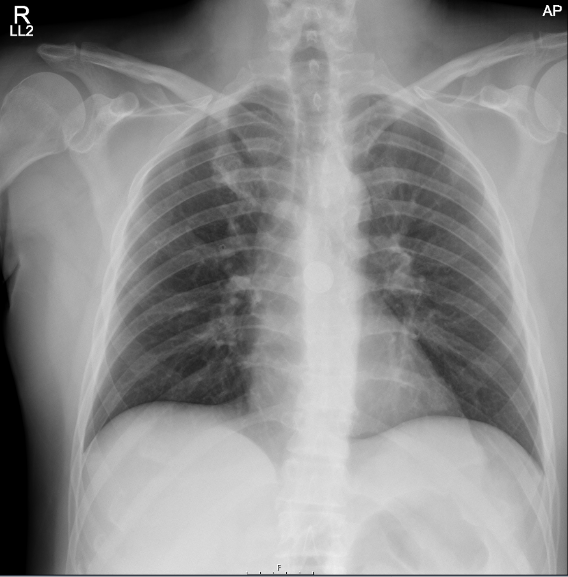Sunday Poster Session
Category: General Endoscopy
P0899 - Neglected Risk in Adults: Severe Esophageal Necrosis Following Button Battery Ingestion
Sunday, October 26, 2025
3:30 PM - 7:00 PM PDT
Location: Exhibit Hall

Akanksha Togra, MD (she/her/hers)
Texas Tech University Health Sciences Center, El Paso
El Paso, TX
Presenting Author(s)
Akanksha Togra, MD1, Jesus Guzman, MD2, Bhavi Trivedi, MD3, Marc J. Zuckerman, MD2, Sherif E. Elhanafi, MD3
1Texas Tech University Health Sciences Center, El Paso, El Paso, TX; 2Division of Gastroenterology, Department of Internal Medicine, Texas Tech University Health Sciences Center, El Paso, TX., El Paso, TX; 3Texas Tech University Health Sciences Center, El Paso, TX
Introduction: Button battery ingestion is most commonly observed in children and typically warrants urgent endoscopic removal. However, there is a lack of clear guidance regarding the urgency of endoscopic intervention in adults. This case illustrates an adult patient who required emergent endoscopic retrieval following button battery ingestion complicated by severe esophageal necrosis.
Case Description/
Methods: We report the case of a 40-year-old male with a history of psychiatric illness who presented with acute dysphagia following intentional ingestion of a button battery. Laboratory studies were unremarkable, and radiographic imaging confirmed a button battery lodged in the mid-esophagus (Figure 1). Urgent endoscopy, performed approximately two hours after presentation, revealed the battery embedded at 30 cm from the incisors with underlying severe mucosal necrosis (Figure 2), classified as Zargar grade 3A. The battery was retrieved using a Roth net after extensive irrigation. The patient was managed conservatively with intravenous antibiotics, proton pump inhibitors, and parenteral nutrition. Follow-up endoscopy after one week demonstrated partial mucosal healing, after which the patient was transitioned to oral intake and discharged with plans for outpatient endoscopic follow-up.
Discussion: This case underscores the importance of prompt endoscopic intervention for button battery ingestion, given the high risk of mucosal injury and necrosis, especially when the battery remains lodged and fails to progress distally. While clear recommendations for immediate removal exist in pediatric guidelines, adult-specific guidance on management strategies remains limited.

Figure: Figure 1: Chest X ray showing button battery lodged in mid esophagus

Figure: Figure 2: Endoscopy showing (a) Lodged button battery (b) Retrieval with Roth net (c) Esophageal necrosis noted after removal
Disclosures:
Akanksha Togra indicated no relevant financial relationships.
Jesus Guzman indicated no relevant financial relationships.
Bhavi Trivedi indicated no relevant financial relationships.
Marc Zuckerman indicated no relevant financial relationships.
Sherif Elhanafi indicated no relevant financial relationships.
Akanksha Togra, MD1, Jesus Guzman, MD2, Bhavi Trivedi, MD3, Marc J. Zuckerman, MD2, Sherif E. Elhanafi, MD3. P0899 - Neglected Risk in Adults: Severe Esophageal Necrosis Following Button Battery Ingestion, ACG 2025 Annual Scientific Meeting Abstracts. Phoenix, AZ: American College of Gastroenterology.
1Texas Tech University Health Sciences Center, El Paso, El Paso, TX; 2Division of Gastroenterology, Department of Internal Medicine, Texas Tech University Health Sciences Center, El Paso, TX., El Paso, TX; 3Texas Tech University Health Sciences Center, El Paso, TX
Introduction: Button battery ingestion is most commonly observed in children and typically warrants urgent endoscopic removal. However, there is a lack of clear guidance regarding the urgency of endoscopic intervention in adults. This case illustrates an adult patient who required emergent endoscopic retrieval following button battery ingestion complicated by severe esophageal necrosis.
Case Description/
Methods: We report the case of a 40-year-old male with a history of psychiatric illness who presented with acute dysphagia following intentional ingestion of a button battery. Laboratory studies were unremarkable, and radiographic imaging confirmed a button battery lodged in the mid-esophagus (Figure 1). Urgent endoscopy, performed approximately two hours after presentation, revealed the battery embedded at 30 cm from the incisors with underlying severe mucosal necrosis (Figure 2), classified as Zargar grade 3A. The battery was retrieved using a Roth net after extensive irrigation. The patient was managed conservatively with intravenous antibiotics, proton pump inhibitors, and parenteral nutrition. Follow-up endoscopy after one week demonstrated partial mucosal healing, after which the patient was transitioned to oral intake and discharged with plans for outpatient endoscopic follow-up.
Discussion: This case underscores the importance of prompt endoscopic intervention for button battery ingestion, given the high risk of mucosal injury and necrosis, especially when the battery remains lodged and fails to progress distally. While clear recommendations for immediate removal exist in pediatric guidelines, adult-specific guidance on management strategies remains limited.

Figure: Figure 1: Chest X ray showing button battery lodged in mid esophagus

Figure: Figure 2: Endoscopy showing (a) Lodged button battery (b) Retrieval with Roth net (c) Esophageal necrosis noted after removal
Disclosures:
Akanksha Togra indicated no relevant financial relationships.
Jesus Guzman indicated no relevant financial relationships.
Bhavi Trivedi indicated no relevant financial relationships.
Marc Zuckerman indicated no relevant financial relationships.
Sherif Elhanafi indicated no relevant financial relationships.
Akanksha Togra, MD1, Jesus Guzman, MD2, Bhavi Trivedi, MD3, Marc J. Zuckerman, MD2, Sherif E. Elhanafi, MD3. P0899 - Neglected Risk in Adults: Severe Esophageal Necrosis Following Button Battery Ingestion, ACG 2025 Annual Scientific Meeting Abstracts. Phoenix, AZ: American College of Gastroenterology.
